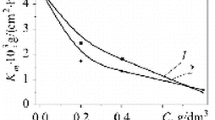Summary
The acidity of wood and its polyphenolic content are shown to be primary factors concerned in the corrosion of sawblade steels (Krilov 1985). Those polyphenolic compounds which possess two or three adjacent hydroxyl groups are particularly important because of their ability to form iron chelates. In this paper some fundamental aspects of chemical corrosion are discussed and a general reaction scheme is proposed for the corrosion of steel by polyphenolic compounds. The validity of these assumptions is supported by experimental results. Better knowledge of steel corrosion chemistry should be of considerable practical benefit to both timber conversion and building industries.
Similar content being viewed by others
References
Browning, B. L. 1963: The chemistry of wood. New York: Wiley
Browning, B. L. 1967: Methods of wood chemistry. Vol. 2. New York: Wiley
Buchanan, M. A. 1963: Exraneous components of wood, Chap. VII. In: Browning, B. L.: The chemistry of wood. New York: Wiley
Farmer, R. J. 1962: Corrosion of metals in association with wood, Part 1: Corrosion by acidic vapours from wood. Wood 27: 443–446
Hillis, W. E.; McKenzie, W. M. 1964: Chemical attack as a factor in the wear of woodworking cutters. For. Prod. J. 14: 310–312
Krilov, A. 1985: Effects of commercial timbers on the corrosion and wear of sawblade steels, Part 1: Laboratory assessments of loss in weight and thickness of four steels. For. Comm. Int. Rep. No. 1044
Krilov, A. 1986: Corrosion under atmospheric conditions, Part 1: Corrosive effect of moist sawdust on sawblade steel. For. Comm. Int. Rep. No. 1175 (in print)
MacLean, H.; Gardner, J. A. F. 1953: Heartwood extractives in digester corrosion. Pulp Pap. Mag. Can. 54 (12): 125
Moore, W. E.; Johnson, D. B. 1967: Procedures for the chemical analysis of wood and wooden products. U.S. For. Prod. Lab., Dept. of Agriculture
Packman, D. F. 1960: The acidity of wood. Holzforschung 14: 178–183
Swain, T.; Hillis, W. E. 1959: The phenolic constituents of Prunus domestica, Part 1: The quantitative analysis of phenolic constituents. J. Sci. Food Agric. 10: 63–68
Wilkes, J. 1984: The influence of rate of growth on the density and heartwood extractives content of eucalypt species. Wood Sci. Technol. 18: 113–120
Author information
Authors and Affiliations
Additional information
The authors wish to acknowledge the assistance of Dr. H. G. M. Dowden in the preparation of this manuscript. The technical assistance of Mr. D. P. Wraight and constructive criticisms of Dr. P. M. Cornish and Mr. R. R. Horne are also gratefully acknowledged
Rights and permissions
About this article
Cite this article
Krilov, A., Gref, R. Mechanism of sawblade corrosion by polyphenolic compounds. Wood Sci.Technol. 20, 369–375 (1986). https://doi.org/10.1007/BF00351589
Received:
Issue Date:
DOI: https://doi.org/10.1007/BF00351589




